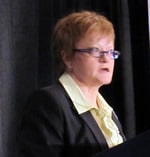 |
Nick Bala Key points: Child witnesses experienced many difficulties prior to legislative reforms (2006, Bill C-2). Use of testimonial aids is now presumptive. Cross-examination of a child by self-represented accused is not permitted. With amendments to the CEA, there is a presumption of capacity of a child witness to testify. A survey conducted of judges a year after C-2, shows 96{c0ca929c5633088f41a8b4e1efe5eb563b0a19a50230288a9321bd7f05521e0f} agreed that the end of competency inquiries is a good change. Investigations are improved due to more training. Challenges continue for children testifying in court. See presentation: [Bala] Child Witnesses in Criminal Courts: Legislation, Judicial Perceptions & Cases See full paper: [Bala, et al] Testimoninal Aid provisions_C-2_case law |
|
|
|
 |
Jean Clinton Key points: Your brain is sculpted by a lifetime of experiences. Genes provide the hardware but early experience is the software that drives the system. Early experiences affect the architecture of the maturing brain. Three levels of stress are: positive, tolerable and toxic – it is the last that can impair the developing brain. Adverse experiences in childhood double the risk for adult PTSD. She closed with a summary of the keys to healthy brain development. See presentation: [Clinton] Toxic Stress and the Brain: Impact of trauma on developing brain |
|
|
|
 |
Susan McDonald Key points: statistics based on data from Statistics Canada, highlighting the rates of violent victimisation amongst youth aged 15 to 17. In 2009, over half of sexual victims were under age 18, and 60{c0ca929c5633088f41a8b4e1efe5eb563b0a19a50230288a9321bd7f05521e0f} were aged from 12 to 17. The Territories have the highest rates of sexual assault. There is a rise in the number of cases involving child pornography and luring. She challenged us with these questions: Are we serving our youth? What are the needs of our youth? How are we addressing those needs? See presentation: [McDonald] Statistics – prevalence of the problem |
|
|
|
 |
Chris Newlin Key points: Child sexual abuse is a serious problem that needs specialized response. In the past, child victims who disclosed were often re-traumatized by the system. In providing specialized responses to children, there is no “one way” – no community has it all.Collaboration is free – it is a matter of time and effort, open communication and sharing resources. A CAC provides one child-friendly place, rather than scattered programs. A strong safety net is necessary for the child –it is a patchwork that includes law enforcement, prosecution, child protection. Don’t spend time making the perfect web – just keep going. Key elements of a CAC were listed. Cost benefit analysis shows that CACs are effective and save public money. See presentation: [Newlin] CACs : What is rationale & need?
“Children’s Advocacy Centers – Are They Working?” Key points: Outcomes are complex and hard to measure. Measured variables can include: conviction rates, health and well-being of children, higher incidence of reported abuse, a more positive experience for the child. Summaries of research studies were presented, highlighting best practices and focusing on a multi-site evaluation comparing communities with and without a CAC. Cases are processed faster and more efficiently in communities with CACs. The key is the multi-disciplinary coordinated approach. CACs help prevent child abuse by documenting cases, improving prosecution and response rates. The visual presence of a CAC in a community creates public awareness of child abuse. See presentation: Children’s Advocacy Centers – Are They Working? |
|
|
|
 |
Barb Spencer, (no PowerPoint presentation) |

CHILD & YOUTH ADVOCACY CENTRES
Building Better Services for Children and Youth who are Victims or Witnesses of Crime in Canada